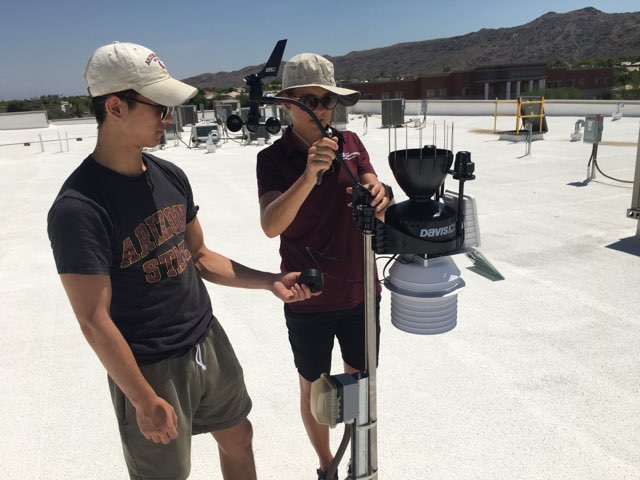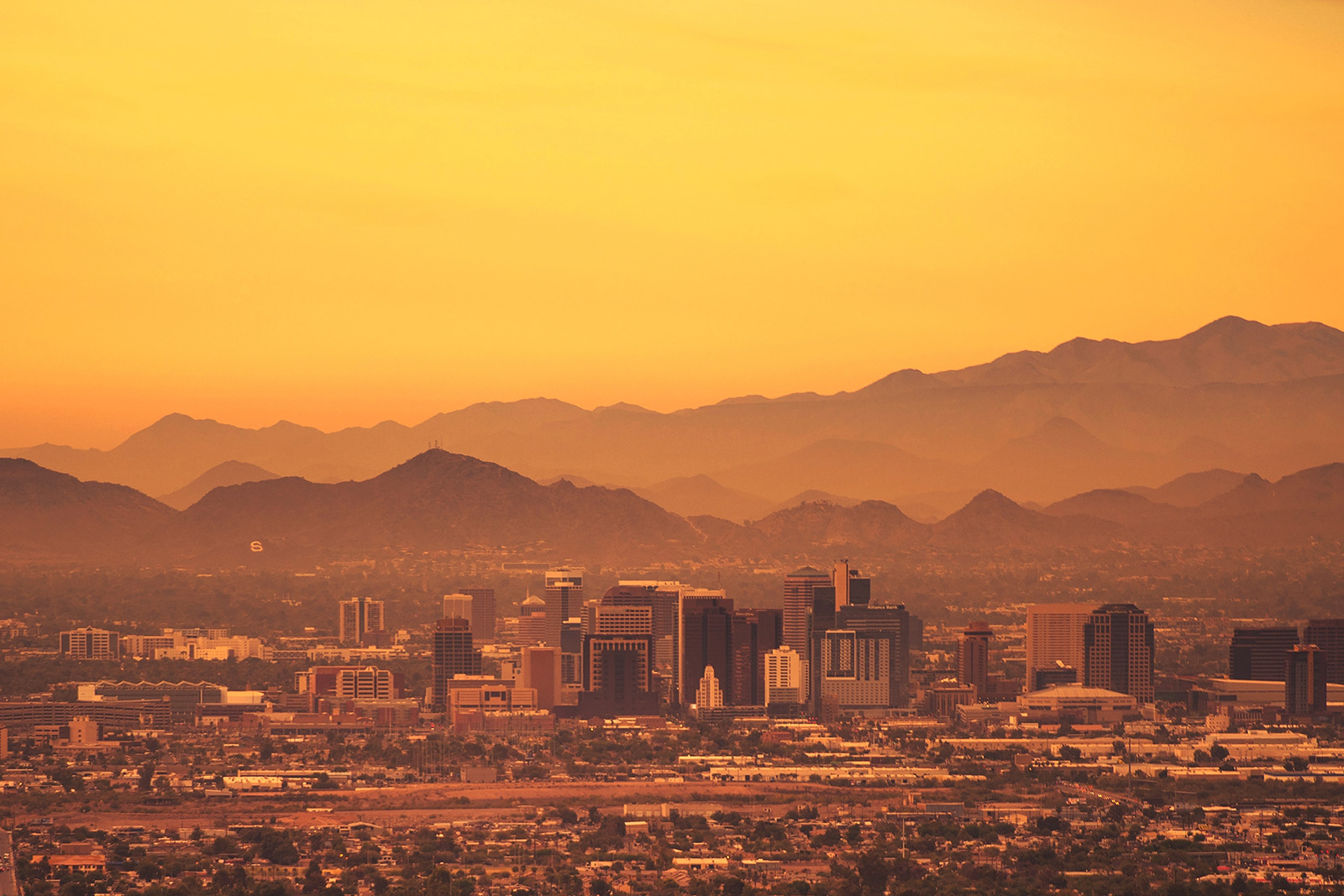Solutions-focused innovation for a healthier living environment
 The Healthy Urban Environments initiative at Arizona State University is focused on convening and translating evidence-based research and evaluation of heat mitigation and air-quality management efforts intro useful solutions that can be implemented across Maricopa County.
The Healthy Urban Environments initiative at Arizona State University is focused on convening and translating evidence-based research and evaluation of heat mitigation and air-quality management efforts intro useful solutions that can be implemented across Maricopa County.
The projects listed on this page represent work being supported by HUE as part of its mission to coalesce and incubate research, policy and technology projects that have real-world applications for urban heat and air-quality solutions. These projects range from empirical field data collection and testing to developing policy tools and technologies that support governance and management interventions around urban heat and air-quality. Importantly, to ensure HUE achieves its commitment to place-based change, many of these projects actively involve Maricopa County stakeholders such as individuals, communities, elected and appointed officials, non-profits, and private businesses.

AZ Heat Preparedness and
Resilience Workgroup
This Workgroup was created in the summer of 2020 to share heat forecasts and warnings with communities; highlight approaches to heat relief, communications strategies and resources; identify opportunities and gaps in heat-related research; and connect cities and counties to regional and state resources and information.
Projects
Advancing Decision Support for Tree and Shade Equity in Maricopa County
Increasing urban tree coverage and shade availability is a focal point of many municipal plans in Maricopa County. This project is building a next-generation, publicly accessible, customizable decision support tool for guiding equitable tree and shade investments. The Tree Equity Score Analyzer for Maricopa County (TESA-MC) will be a community-shaped web map and modeling environment that integrates a wide suite of data, modeling, and information technology resources available from Arizona State University, American Forests, municipalities, and other partners. This project will produce a publicly-accessible web tool (TESA-MC) that integrates a wide suite of data resources to enable unprecedented and customized exploration, querying, and scenario evaluation.



Building a Targeted Real-Time Warning System to Prevent Indoor Heat Deaths
This project seeks to continue testing and building a real-time, targeted, knowledge-sharing platform that would issue alerts when dangerously hot conditions are measured inside one’s home. These alerts would trigger wellness checks by neighbors, family members, or other support personnel, and ultimately help connect vulnerable residents to a larger network of resources and assistance.


Crowdsourced Heat and Indoor Air Study
This project aimed to investigate exposure to both heat and air pollution (fine particulates), and the differences between indoor and outdoor exposure. The goal was to have students act as "citizens," providing them with low-cost air pollution and temperature sensors to make measurements in their homes and daily lives (by carrying the sensors) to assess their exposure. An additional objective was to develop a teaching module to enhance the students' understanding and awareness of air and heat issues.

Design, Development and Testing of Innovative Paving Materials for Urban Cooling
Asphalt is an incredibly common component of the urban landscape. By testing a new approach to improve thermal behavior of asphalt binders, this project aims to improve the thermal characteristics of asphalt, improve asphalt paving longevity, and reduce the contribution of asphalt surfaces to urban heat.



Design, Development, Testing and Modeling of Innovative Building Materials for Urban Cooling
Quantifying interaction between heat flux and temperature in urban areas is imperative to evaluate interventions to mitigate urban heat islands. This work will develop models to simulate the potential cooling benefits of novel paving and building materials in different climatic zones.



Developing and Testing HeatReady Standards for Cities
Cities continue to face challenges in organizing and standardizing governance approaches and evaluation around urban heat. This project proposes to develop the HeatReady standard to support effective regional heat governance, and pilot these standards across several local municipalities.





ECO PHX Project
ECO PHX, located at 301 W. Roosevelt Street, is a mixed-use urban infill development of 70 apartment homes and six commercial spaces in downtown Phoenix.





Encouraging Teleworking as a Strategy to Reduce Ozone from Commute Trips in Maricopa County
This project will develop a telecommuting toolkit that contains a concise, graphical guide for Human Resources departments seeking to develop telecommuting programs. The toolkit will be developed to up scale the project in other municipalities.

Galvanizing Practitioner’s Wisdom: Co-creating a Cool Region Webtool for Regional Community Resilience and a Regional Cooling Authority
This project builds off the HUE project Heat and Health Maps for Decision Making in Tempe and connects it to the City-University effort with Cool Kids, Cool Places, Cool Futures/Neighborhood Justice in Tempe, to bring decision making approaches (using integrated heat, health, and equity data) for critical equitable urban cooling infrastructures (that link locations with corridors to each other) to the regional level.



Heat and Health Maps for Decision Making in Tempe
Heat is a common health crisis in our region, and it hits vulnerable populations first and worst. The Tempe Heat Intervention Mapping project will improve the city's ability to devise data-informed decisions and actions regarding extreme heat that will improve community health and well-being.



HeatReady Neighborhood
The goal of this HUE project is to develop a HeatReady Neighborhood that is prepared for extreme heat emergencies and works towards long-term heat mitigation solutions that create more thermal comfort for its residents.

HeatReady Schools
This research targets schoolchildren and heat preparedness within schools to mitigate high temperatures and health concerns. The goal is to create an evaluation tool for “HeatReady Schools,” whereby HeatReady Schools are those that are increasingly able to identify, prepare for, mitigate, track and respond to the negative impacts of heat.






How Does EV Adoption Affect Air Quality for Low-Income Households?
This project analyzes the impact of electric vehicle adoption scenarios on air pollutants in Maricopa County. We particularly focus on air quality impacts for low-income and minority communities, which are disproportionately burdened due to their proximity to highways and industrial zones.



Increasing Heat Awareness in Manufactured and RV Homes
Through surveys and workshops, this project aims to analyze risks and challenges of extreme heat faced by mobile home residents. Based on findings, the project will develop and disseminate toolkits highlighting mobile home-specific adaptations, mitigations and resources.


Making Visible the Invisible: An Art-Based Approach to Engaging Community in Air Quality Monitoring in South Phoenix
An art installation will display air quality data in real-time and that will be used as a tool for science engagement and communication. During the duration of this project there will be community engagement opportunities to bring the conversation on air quality and health equity to public spaces in the community.


Measuring the Urban Canopy and Cool Corridors
This project will update the tree shade canopy percentage for the City of Phoenix. The project will also produce graphics and visualizations to be used for public engagement.


Mesa CARE Resilience Hub
This project will create a Resilience Hub that supports all residents and will respond to heat and air quality challenges during the summer, emergencies, and recovery times while addressing inequalities and their root causes. This demonstration project will create a healthier urban environment by using community based participatory research methods.

Mobile Cooling Center
This project retrofitted a trailer into a mobile cooling center that provides air-conditioning, cold water, Wi-Fi and resources to the City of Tempe homeless population. This pilot aims to create a mobile cooling center that doesn’t impact air quality by using solar panels.

Neighborhood-Scale Comparison of Heat Mitigation Strategies Phoenix
Understanding the potential impacts of changes to the form and arrangement of the built environment is critical to supporting improved thermal characteristics and comfort in neighborhoods. Through the combined use of field monitoring and neighborhood scale atmospheric modeling, this work will characterize the air flow and heat transfer dynamics of existing and proposed designs of a residential community in Phoenix, AZ.


Online Decision-Making Tool for Active Shade Management
This project aims to develop a web-based simulation tool that generates shade performance curves for arbitrary shade types, locations, dates, and times of day. This tool will translate empirical findings into usable science by making comprehensive shade assessments accessible at no costs to City staff, developers, and the general public in Tempe, the Southwest, and across the nation.





Phoenix Zoo Parking Project
The City of Phoenix, in cooperation with the Arizona Center for Nature Conservation/Phoenix Zoo, is retrofitting and expanding the parking area used by the zoo. The new parking lot will utilize features to address heat and storm water issues, such as shade trees, storm water swales and increased shade structures along pedestrian pathways.








Photocatalysts on Solar Panels for NOx Control
Nitrogen oxides (NOx) play a significant role in reducing urban air quality, often playing a role in contributing to photochemical smog pollution events. This project seeks to develop a coating to enable the front surfaces of photovoltaic (solar) panel installations to actively remove NOx from the urban atmospheres.


Quantifying the Air Quality Benefit of a Novel Dust Suppression Technique
Uncovered land surfaces can contribute high levels of suspended particles, particularly near or at urban construction sites. While traditionally water is used as an effective but temporary solution to control dust entrainment, this project explores a novel technique to stabilize soil surfaces and reduce the release of particles from these sites.


Re-imagining Outdoor Play and Learning Environments — Paideia Academies
In 2019, ASU researchers and Paideia Academies ambitiously set out to address the challenges of schoolyard exposures to heat and air pollution and to manage stormwater through revitalizing their playspaces as natural play and learning environments.







Reflective Parking Lots
Maricopa County and its municipalities are exploring the potential for reflective asphalt coatings to lower urban temperatures and provide benefits to County residents. This project will measure the surface energy balance and near-surface temperatures before and after coating application, will simulate widespread implementation of reflective coatings, and will analyze benefit-costs across Maricopa County.


Revitalizing and Reimagining Outdoor Play and Learning Environments
This HUE project will extend and amplify the existing efforts at Paideia Academies, to ensure that long-term air quality and microclimate monitoring can continue. It also aims to enhance these measurements with new data collection related to water use, soil temperatures, and evaporation, as questions around water often arise when heat solutions using re-greening are posed.






Sustainable Asphalt Roofing Technology Solution for Heat Mitigation Strategies
. This project proposed the modification of asphalt shingles with an encapsulated aerogel product, called Aerogel Modified Bituminous material (aMBx); it was developed recently at Arizona State University.




The Right Shade in the Right Place: Thermal Assessment of Natural and Engineered Shade in Tempe
Improving thermal comfort experiences in urban areas depends on understanding how shade contributes to thermal comfort in various contexts. This project uses an mobile field monitoring station to evaluate the impact of various types of shade and their urban contexts on thermal comfort.


Unlimited Potential
The goal of this project is to engage, educate, and empower community members and help them understand the interconnection of asthma, pollution, and climate change. This project is led by Unlimited Potential, a community based organization in south phoenix.





Waking Up Wall Street
Vibrant alleyways are beneficial to health, community development, and the environment. Transforming dark, unsafe, unattractive, and underutilized alleyways such as Wall Street, an alley in downtown Chandler, into a livable public space presented a unique opportunity for people and businesses to thrive. By encouraging walkability, promoting social interaction, and implementing creative street design elements, the “Waking up Wall Street” project became a true asset to Chandler’s community. This conversion also aligned with the City of Chandler’s goals to enhance its downtown identity and Maricopa County’s efforts to mitigate heat and improve air quality.




Total: 30


